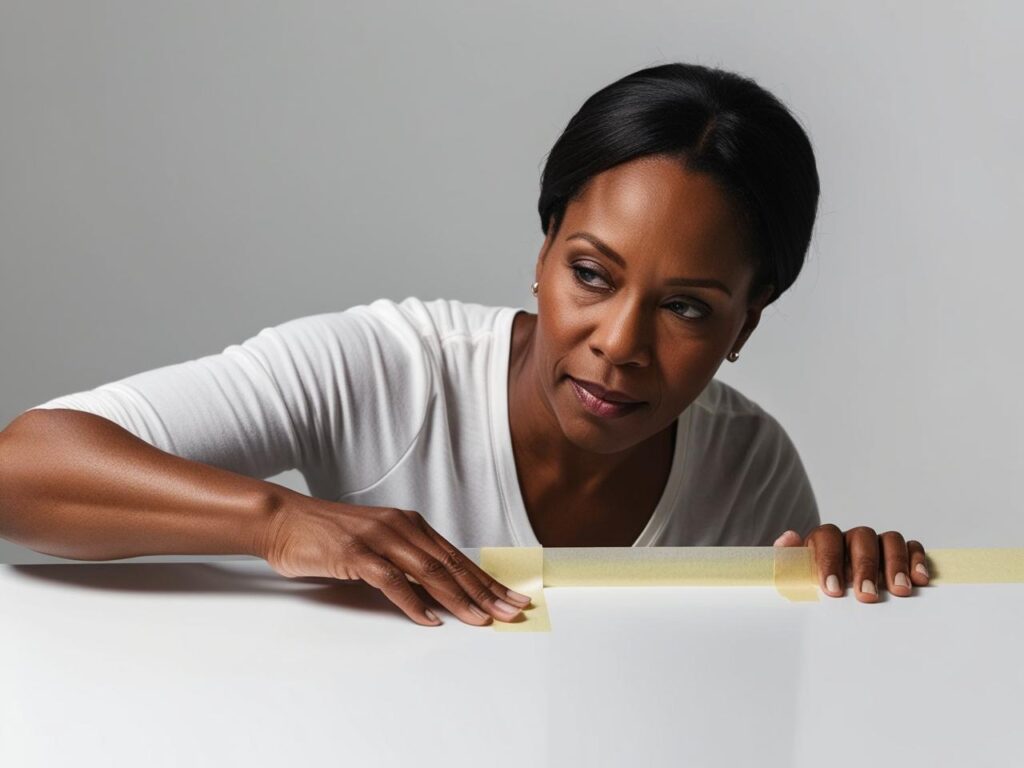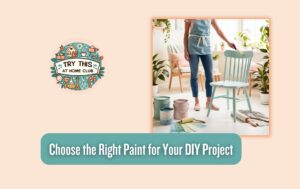Diving into the world of DIY painting can feel a little overwhelming, but with the right guidance, it becomes a fun and satisfying way to transform your space and items without breaking the bank. Whether you’re working on furniture, walls, or small decor items, these beginner DIY painting tips will help you achieve beautiful results while keeping things easy and affordable. Let’s jump into the basics, learn some professional tricks, and get you started on your next DIY project!
Table of Contents
Why Choose DIY Painting?
Painting is one of the simplest and most affordable ways to update your space or breathe new life into old furniture. Here are a few reasons why beginner DIY painting projects are perfect for anyone starting out:
- Cost-effective: You can create a brand-new look for a fraction of what you’d pay for new items or a professional service.
- Accessible materials: Most painting supplies are affordable and available at your local hardware or craft store.
- Easy to learn: With a few basic tips, anyone can pick up DIY painting techniques that look professional.
- Highly rewarding: There’s nothing like the satisfaction of admiring a piece that you’ve transformed with your own hands!
With these essentials in mind, let’s dive into the best painting tips for beginners.
1. Preparation is Key – Start with Clean Surfaces
One of the first beginner DIY painting tips that many overlook is proper surface preparation. Painting on a dirty or uneven surface leads to a rough finish that doesn’t last as long. Here’s how to prep like a pro:
Cleaning Tips for Different Surfaces:
- Wood: Sand lightly, then wipe down with a damp cloth to remove dust.
- Metal: Use a degreasing cleaner to remove oils or dirt.
- Walls: Clean with a mild detergent solution to eliminate dust and grime.
Pro Tip: For stubborn spots, use a mix of water and vinegar for effective, eco-friendly cleaning.
2. Choose the Right Paint and Tools for the Job
Choosing the right paint and tools is crucial to getting the result you want. The best beginner DIY painting tips always recommend matching your paint type and tools to your project.
Paint Types for Different Projects:
- Acrylic Paint: Ideal for furniture and decor projects, as it’s water-based, easy to clean up, and dries quickly.
- Latex Paint: Perfect for walls and larger surfaces, with great durability and coverage.
- Chalk Paint: Great for a matte, vintage finish on furniture and easy to distress.
Must-Have Painting Tools:
- Brushes: Invest in a good set of brushes, from small ones for details to larger ones for broad surfaces.
- Rollers: Rollers are best for large, flat areas like walls and tabletops.
- Painter’s Tape: Essential for achieving crisp, clean lines and protecting edges.
Pro Tip: Quality tools last longer and give a smoother finish. Don’t skimp on brushes if you want a professional look!
3. Master the Basics of Priming
Priming helps paint adhere better and makes colors look more vibrant. It’s especially important when painting surfaces like wood or dark-colored walls.
How to Apply Primer:
- Use a small amount and apply a thin, even layer.
- Allow it to dry completely before moving on to your paint.
- For best results, lightly sand after the primer dries and clean off dust for a smoother finish.
Pro Tip: Skip the primer for chalk paint projects, as it usually adheres well on its own!
4. Use the Right Brush Technique for Smooth Results
Brush technique can make a huge difference in your DIY painting project. Here are some essential beginner DIY painting tips for achieving a smooth, even finish:
Brush vs. Roller:
- Brushes: Best for detail work, edges, and smaller surfaces.
- Rollers: Great for large, flat surfaces like walls or tabletops.
Essential Brush Techniques:
- Avoid Overloading: Dip only the tip of the brush in paint to prevent drips.
- Brush in One Direction: Helps avoid streaks and creates a smoother surface.
- Feather Out the Edges: Lightly brush out any lines or streaks for a seamless look.
Pro Tip: Always work with the wood grain (if painting wood) for the best finish!
5. Practice Patience with Drying Times
One of the most common beginner DIY painting mistakes is not allowing enough drying time between coats. Rushing the process can cause streaks, bubbling, or uneven color.
Typical Drying Times:
- Water-based paints: Usually dry to the touch within 1-2 hours but wait 4-6 hours for the next coat.
- Oil-based paints: Can take 6-8 hours to dry; allow 24 hours before recoating.
Pro Tip: Check the paint can for exact drying times, as each type of paint has different recommendations.
6. Easy Tips for Taping and Edging Like a Pro
Using painter’s tape helps achieve clean, professional-looking lines, especially when working around edges or multiple colors.
Tips for Using Painter’s Tape:
- Apply tape to clean, dry surfaces to prevent peeling.
- Press down firmly along the edge of the tape to prevent paint from seeping under.
- Remove tape at a 45-degree angle while the paint is still wet to avoid peeling off the paint.
Pro Tip: For curved or irregular edges, try a flexible tape or lightly cut it with a craft knife for a perfect fit.

7. Apply Multiple Light Coats for Best Results
When it comes to painting, it’s tempting to apply a thick coat to finish quickly, but lighter coats always yield better results.
Tips for Applying Light Coats:
- Start with a light coat and let it dry completely before applying the next.
- For bold colors, expect to use 2-3 coats for full coverage.
- Avoid re-brushing or overworking the paint as it dries to prevent streaks.
Pro Tip: Thin coats dry faster and are less prone to dripping, creating a smoother, more even surface.
8. Finishing Touches – Add a Protective Topcoat
For pieces that get a lot of wear, like furniture or decor, a protective topcoat will add durability and a polished look.
Types of Topcoats:
- Polyurethane: Provides a clear, durable finish that’s perfect for high-use items.
- Wax Finishes: Adds a softer, matte finish ideal for chalk-painted pieces.
- Acrylic Sealants: Great for quick-drying and UV protection on indoor/outdoor decor.
Pro Tip: Be sure to choose a compatible topcoat for your paint type to avoid bubbling or peeling.
9. Clean-Up Tips to Save Time and Extend Tool Life
Cleaning up properly after a painting project is essential to maintain your tools and keep everything in good condition for future DIY projects.
Cleaning Brushes and Rollers:
- Water-based paint: Rinse with warm water and mild soap until clear.
- Oil-based paint: Use mineral spirits or a paint thinner to clean brushes and rollers.
Paint Disposal and Storage:
- Store paint in a cool, dry place, and cover tightly to prevent it from drying out.
- Safely dispose of unused paint by contacting local waste disposal or recycling programs.
Pro Tip: Wrap brushes in plastic wrap between coats to keep them moist without washing them every time.
10. Start Your First DIY Painting Project with Confidence!
With these beginner DIY painting tips, you’re ready to dive into your first project with confidence! Remember, practice and patience are key. Painting is a creative, affordable, and incredibly satisfying way to add personality to your space, and with each project, you’ll find yourself improving and enjoying the process even more. So grab your brushes, pick out some colors, and start transforming your home today!
Ready, Set, Paint: Embrace Your DIY Journey!
With these beginner DIY painting tips in hand, you’re all set to tackle your first project with confidence and creativity! Whether you’re updating a piece of furniture, adding a splash of color to a room, or creating custom decor, DIY painting allows you to express your unique style while keeping things affordable and fun. Remember, the more you practice, the better you’ll get—so don’t be afraid to experiment and enjoy the process. Now, all that’s left is to pick up your brush and start creating something beautiful. Here’s to your journey in DIY painting!
Happy painting!






[…] 10 Essential Beginner DIY Painting Tips Every New Painter Needs to Know Tags# beginner# beginner DIY projects# budget-friendly paint# cozy# creative# DIY# DIY paint tips# DIY painting for beginners# DIY painting hacks# furniture# home decor# home decor DIY# how to choose the right paint# paint# paint finishes# paint for furniture# paintbrush […]